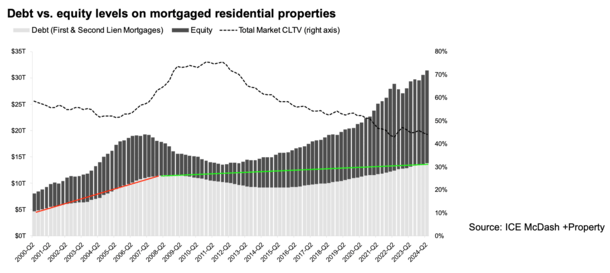I sometimes wonder with so little equity extracted this cycle if it’s still early innings for the housing market. At least in terms of the next collapse.
Sure, home sales volume has plummeted thanks to unaffordable conditions, driven by high home prices and significantly higher mortgage rates.
But do we still need a flood of HELOCs and cash out refis before the market inevitably overheats again?
Otherwise it’s just an unaffordable market that is likely just going to get more affordable as mortgage rates ease, home prices stall, and wages increase.
Where’s the fun in that?
Homeowners Were Maxed Out in the Early 2000s
If you look at outstanding mortgage debt today, it really hasn’t risen much over the past 16 or so years when the housing bubble popped.
It skyrocketed in the early 2000s, thanks to rapidly rising home prices and zero down financing.
And a flood of cash out refinances that went all the way to 100% LTV and beyond (125% financing anyone?).
Basically homeowners and home buyers back then borrowed every penny possible, and then some.
Either they cashed out every six months on higher valuations, fueled by shoddy home appraisals, or they took out a HELOC or home equity loan behind their first mortgage.
Many also purchases investment properties with no money down, and even without any documentation.
Whatever it was, home buyers back then always maxed out their borrowing capacity.
It was kind of the move back then. Your loan officer or mortgage broker would tell you how much you could afford and you would max that out. There was no reason to hold back.
If it wasn’t affordable, stated income would just be stated higher to make it pencil.
Exacerbating that was faulty home appraisals that allowed property values to go up and up and up.
Of course, it wasn’t long before the bubble burst, and we saw an unprecedented flood of short sales and foreclosures.
Many of those mortgages were written off. And a lot of that money was used to buy discretionary toys, whether it was a new speedboat or a hummer or ironically, a second home or rental property.
Most of it was lost because it simply wasn’t affordable.
And it didn’t need to be because the majority of the loans back then were underwritten with stated income loans or no doc loans.
Outstanding Mortgage Debt Is Low Relative to the Early 2000s

Today, things are a lot different in the housing market. Your typical homeowner has a 30-year fixed mortgage. Maybe they even have a 15-year fixed.
And there’s a good chance they have a mortgage interest rate somewhere between two and four percent. Maybe even lower. Yes, some homeowners have rates that start with a “1.”
Many of them also purchased their properties prior to the big run up in prices prior to the pandemic.
So the national LTV is something ridiculously low below 30%. In other words, for every $1 million in house value, a borrower only owes $300,000!
Just look at the chart from ICE that shows the massive gap between debt and equity.
Consider your average homeowner having a ton of home equity that is mostly untapped, with the ability to take out a second mortgage and still maintain a large cushion.
Long story short, many existing homeowners took on very little mortgage debt relative to their property values.
Despite this, we continue to suffer from an affordability crisis. Those who have not yet bought in often can’t afford it.
Both home prices and mortgage rates are too high to qualify new home buyers.
The problem is, there isn’t much reason for home prices to ease because existing owners are in such a good position. And there are too few available, for-sale properties.
Given how high prices are, and how poor affordability is, there are some that think we are on another bubble. But it’s difficult to get there without financing.
And as noted, the financing has been pretty pristine. It’s also been very conservative.
In other words, it’s hard to get a widespread crash where millions of homeowners fall behind on their mortgages.
At the same time, existing homeowners value their mortgages more than ever because they’re so cheap.
Simply put, their current housing payment is the best option they’ve got.
In many cases, it would be much more expensive to go rent or to buy a replacement property. So they’re staying put.
Do We Need a Second Mortgage Surge to Bring Down the Housing Market?
So how do we get another housing market crash? Well, I’ve thought about this quite a bit lately.
While housing isn’t the “problem” this time around, as it was in the early 2000s, consumers are getting stretched.
There will come a time where many will need to borrow from their homes to afford everyday expenses.
This could mean taking out a second mortgage, such as a HELOC or home equity loan.
Assuming this happens en masse, you could see a situation where mortgage debt explodes higher.
At the same time, home prices could stagnate and even fall in certain markets due to ongoing unaffordability and weakening economic conditions.
If that happens, we could have a situation where homeowners are overextended once again, with less equity serving as a cushion if they fall behind on payments.
Then you could have a housing market filled with properties that are a lot closer to being maxed out, similar to what we saw in the early 2000s.
Of course, the big difference would still be the quality of the underlying home loans.
And the first mortgages, which if kept intact would still be super cheap, fixed-rate mortgages.
So even then, a major housing crash seems unlikely.
Sure, I could see the more recent home buyers who didn’t get an ultra-low mortgage rate, or a low purchase price, walk away from their properties.
But the bulk of the market is not that homeowner this time around. Sales volume has been low since both high mortgage rates and high prices took hold.
The point here is that we could still be in the early innings of the housing cycle, as strange as that sounds.
That is, if you want to base it on new mortgage debt (borrowing) this cycle.
Because if you look at the chart posted above, it’s clear today’s homeowners just haven’t borrowed much at all.

